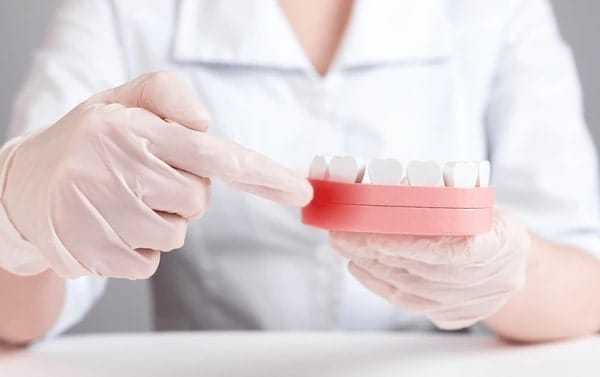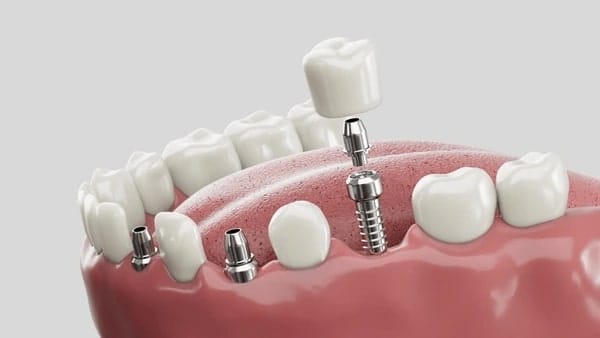Plaque and tartar—two words most of us associate with a dental visit—are far more than minor annoyances. They’re the silent instigators behind many serious oral health issues, particularly those involving your gums. What starts as a harmless, invisible film on your teeth can quickly harden, inflame your gums, and set off a chain reaction that may lead to gum disease and even tooth loss. In this article, we’ll walk you through how plaque becomes tartar, why it’s a threat to your gum health, and how you can stop the damage before it starts.
What Is the Difference Between Plaque and Tartar?
Dental plaque is a soft, sticky film made of bacteria, saliva, and food particles. It constantly forms on your teeth and gums throughout the day—especially after meals. Left undisturbed, this film doesn’t just sit idle. Within 24 to 72 hours, the minerals in your saliva interact with plaque and harden it into tartar (also called dental calculus), which bonds stubbornly to tooth enamel.
Here’s a quick comparison:
| Feature | Dental Plaque | Tartar (Calculus) |
| Composition | Soft, sticky film of bacteria | Hardened plaque containing mineral deposits |
| Colour | Colourless or pale yellow | Yellow or brown, often visible near gumline |
| Time to develop | Forms within hours of eating | Hardens in 24–72 hours if not removed |
| Removal | Brushing and flossing can remove it | Requires professional dental cleaning |
| Gum effects | Irritation and mild inflammation | Leads to gingivitis and potential periodontitis |
Why Does Plaque Turn into Tartar So Quickly?
Plaque thrives in the presence of sugars and starches. The bacteria in plaque break down these particles and produce acid as a by-product. This acid not only weakens enamel but irritates the surrounding gum tissue. When plaque isn’t effectively removed—especially between teeth and along the gumline—it calcifies into tartar. Unlike soft plaque, tartar is tightly bound to the tooth surface and cannot be removed by brushing alone. The longer tartar stays on the teeth, the more damage it can cause to your gums.
What Happens to Your Gums When Tartar Forms?
Tartar acts like an irritant to your gum tissue. It’s rough, porous, and a perfect breeding ground for more bacteria. As tartar builds up along the gumline, it pushes against your gums, triggering inflammation and irritation. Over time, this can lead to:
- Gingivitis – early-stage gum disease with redness and bleeding
- Gum recession – gums pull away from the teeth
- Pocket formation – deep gaps form between teeth and gums
- Bone loss – severe infections damage the jawbone
- Tooth mobility and eventual loss
These conditions don’t happen overnight. But once they begin, the damage can progress silently and often without pain until it becomes difficult to reverse.
How Do You Know If Tartar Is Affecting Your Gums?
Tartar can often be seen along the gumline as yellow or brown hardened patches. But beyond the visible signs, your gums may also give you clues:
| Effect on Gums | Description |
| Inflammation | Swollen, red, and tender gum tissue |
| Gum recession | Gums pulling back and exposing more of the tooth surface |
| Pocket formation | Deepened gaps trapping food and bacteria |
| Tooth mobility | Weakened support leading to loose teeth |
| Tooth loss | Severe gum disease resulting in tooth detachment |
What Are the Early Symptoms to Watch For?
If you experience any of the following signs, plaque and tartar may be affecting your gum health:
- Bleeding during brushing or flossing
- Persistent bad breath
- A gritty feeling on your teeth
- Gums that appear red or swollen
- Yellow or brown stains near your gumline
These early symptoms are often brushed off—no pun intended—but they’re your body’s way of alerting you that your gums are under attack.
How Can You Stop Plaque from Becoming Tartar?
Prevention is the most effective weapon against tartar. Since plaque hardens quickly, consistency in oral hygiene is key:
- Brush twice daily with fluoride toothpaste
- Use floss or interdental brushes to clean between teeth
- Rinse with an antiseptic mouthwash
- Limit sugary and starchy snacks
- Visit your dentist every 6 months for check-ups and professional cleans
Routine dental care and good daily habits go a long way in preventing gum inflammation and the progression of tartar.
What Role Do Dental Visits Play in Managing Tartar?
No matter how thorough your at-home care is, some tartar will likely form—especially in hard-to-reach areas. That’s why professional dental cleans are essential. Your dentist or hygienist will perform scaling, a technique that uses specialised tools to safely remove tartar above and below the gumline.
Regular dental visits help prevent the build-up of tartar that can otherwise silently harm your gums. They also allow early detection of any gum issues before they develop into larger problems.
Why Choose Palm Beach Dental for Tartar and Gum Care?
At Palm Beach Dental, we understand how crucial gum health is to your overall wellness. Our experienced and compassionate team is equipped with the latest dental technology to provide gentle, effective tartar removal and gum care. We don’t just clean your teeth—we help educate you on preventative routines tailored to your specific needs. Whether it’s been six months or a little longer since your last visit, we’re here to help you regain confidence in your smile and maintain healthier gums for life.
Frequently Asked Questions
Q1: Can I Remove Tartar Myself at Home?
No. Once plaque hardens into tartar, it must be professionally removed by a dentist near me using scaling tools.
Q2: How Quickly Does Plaque Become Tartar?
Plaque can begin hardening into tartar within 24 to 72 hours if not removed through brushing and flossing.
Q3: Is Tartar Always Visible?
Often, yes. It can appear as yellow or brown deposits, especially around the gumline and between teeth.
Q4: Does Tartar Always Cause Gum Disease?
While not guaranteed, tartar significantly raises the risk of gingivitis and more serious gum infections.
Q5: What’s the Best Way to Prevent Tartar?
Brush and floss daily, eat a balanced diet, and visit your dentist regularly for professional cleans.
Q6: Can Tartar Cause Long-Term Damage?
Yes. If untreated, tartar can lead to gum recession, bone loss, and eventually, tooth loss.
References (Australia-based)
- Australian Dental Association – Oral Health
- Better Health Channel – Plaque and Tartar
- Dental Health Services Victoria



